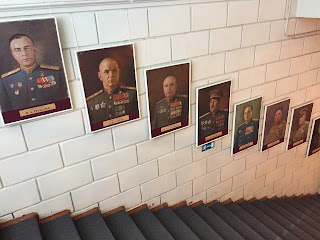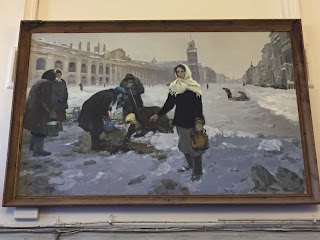13. Museum of the Defense and Siege of Leningrad
I would characterize the Museum of the Defense and Siege of Leningrad as a local history museum, so the building itself and the exhibits inside are more modest than the more well-known institutions I've visited in St. Petersburg. But, what history! The exhibits center on two themes: the military effort to defend the city from the Nazi invasion during the 900-day long siege in 1941-1944, and life (and death) in the city during this time. The stories were told primarily with artifacts and photographs, but there were a fair number of paintings, too.
It's hard to even believe or understand the scale of human suffering here during the Great Patriotic War. Estimates vary, but up to 1 million Soviet soldiers died defending the city, and close to 1 million civilians died as well - some directly from shelling and incendiary bombs, but most from starvation. Two million dead in a single city, representing 2-3% of all deaths during WWII - this truly boggles the mind.
Parts of the exhibit produced quite strong emotions: the display that showed the size of the daily rations for people living in a city almost completely cut off from outside supplies as well as alternative sources of sustenance (wallpaper glue, leather belts, family pets, etc.), a description of the work at the end of the coldest winter in a century to clear the tens of thousands of corpses that were frozen solid in the streets, and pictures of the volunteer crews who went around extinguishing incendiary bombs before they could burn down the whole block. The tales of heroism and courageous action in the face of extreme adversity were quite inspirational. I also enjoyed learning about the performance of Dmitri Shostakovich's Symphony No. 7 "Leningrad" during the blockade, which was broadcast on the radio to let the rest of Russia (and the world) know that the city still had life in it.
I mentioned this visit to several of my colleagues - none had been here before ("too depressing"). However, I thought the stories of the triumph of the human spirit counterbalanced the more gruesome or depressing aspects of this story.
The map above shows the locations in St. Petersburg that were hit by Nazi shelling. Suffice to say that the circles cover pretty much the entire city, including the neighborhood where I currently live.
In the picture below, the rectangle on the right side is a piece of bread that matches the size of the full-day ration that people has to subsist on for months at a time. The items on the left illustrate alternative food sources that people came up with to survive.
It's hard to even believe or understand the scale of human suffering here during the Great Patriotic War. Estimates vary, but up to 1 million Soviet soldiers died defending the city, and close to 1 million civilians died as well - some directly from shelling and incendiary bombs, but most from starvation. Two million dead in a single city, representing 2-3% of all deaths during WWII - this truly boggles the mind.
Parts of the exhibit produced quite strong emotions: the display that showed the size of the daily rations for people living in a city almost completely cut off from outside supplies as well as alternative sources of sustenance (wallpaper glue, leather belts, family pets, etc.), a description of the work at the end of the coldest winter in a century to clear the tens of thousands of corpses that were frozen solid in the streets, and pictures of the volunteer crews who went around extinguishing incendiary bombs before they could burn down the whole block. The tales of heroism and courageous action in the face of extreme adversity were quite inspirational. I also enjoyed learning about the performance of Dmitri Shostakovich's Symphony No. 7 "Leningrad" during the blockade, which was broadcast on the radio to let the rest of Russia (and the world) know that the city still had life in it.
I mentioned this visit to several of my colleagues - none had been here before ("too depressing"). However, I thought the stories of the triumph of the human spirit counterbalanced the more gruesome or depressing aspects of this story.
The map above shows the locations in St. Petersburg that were hit by Nazi shelling. Suffice to say that the circles cover pretty much the entire city, including the neighborhood where I currently live.
In the picture below, the rectangle on the right side is a piece of bread that matches the size of the full-day ration that people has to subsist on for months at a time. The items on the left illustrate alternative food sources that people came up with to survive.




















Comments
Post a Comment